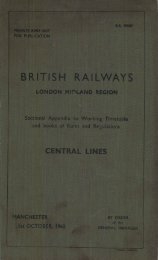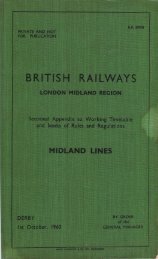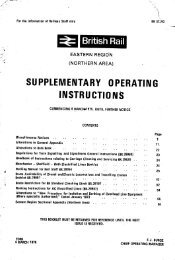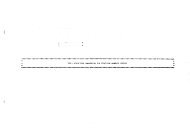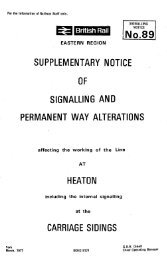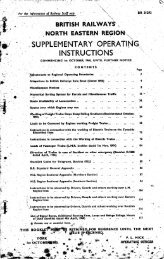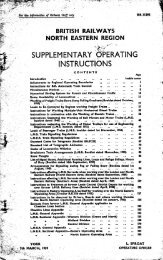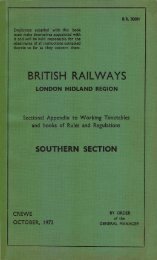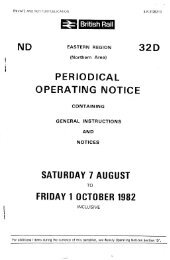general instructions. - Limit Of Shunt
general instructions. - Limit Of Shunt
general instructions. - Limit Of Shunt
Create successful ePaper yourself
Turn your PDF publications into a flip-book with our unique Google optimized e-Paper software.
General Instructions.—Continued. 1 0 3<br />
Instructions as to Working Ground Signal Frames, etc.—Continued.<br />
When the train passes clear into the siding, and the shunting can be done<br />
within the catch points, two beats of the gong must be given, and the points<br />
so set that the bolt lock may at once be replaced.<br />
When the train is ready to return to the Main line, three beats of the gong<br />
must be given, upon which the signalman, if the Main line is clear, will withdraw<br />
the bolt lock, and when the train has been drawn out clear of the siding<br />
points, four beats must be given by the guard as a signal that the train is<br />
ready to proceed on its journey, and the signalman must then replace the<br />
bolt lock.<br />
During foggy weather or snowstorms, or at any time when the signalman<br />
is unable to see a train shunting at the ground frame, the guard or other<br />
person in charge of the latter must, after the line or lines have been cleared,<br />
in addition to giving the "line clear" signal on the gong to the signalman,<br />
verbally inform the latter of the circumstances, and the signalman must not<br />
accept any train until he has been informed. ( O . 108).<br />
SPECIAL TRAMS RANGED BY THE ENGiNEER FOR THE<br />
CONVEYANCE OF COMPANY'S WORKMEN.<br />
General Rule 142. and B.T.R.<br />
When special trains are run for tile. conveyance of Company's workmen<br />
direct from one place to another, and the distance is not less than 15 miles,<br />
the train must be signalled as a Class B Freight train, viz., 5 (1-4), provided<br />
the vehicles are suitable and the conditions of the load and other circumstances<br />
admit of this being done. When such trains are not run under the<br />
B classification, the guard must state the reason on his journal.<br />
When workmen are conveyed for a shorter distance, either in vehicles<br />
specially provided for the purpose, or in vehicles attached to Ballast trains,<br />
they must be signalled strictly in accordance with the Block Telegraph<br />
Regulations, either as a through Ballast train or as a train requiring to stop<br />
in the section, as the case may be. ( O . 1889).<br />
Speed of Light Engines or Engine and Van.<br />
General Rule 145.<br />
Passenger engines, 45 or up to 55 miles per hour, when necessary.<br />
Freight engines with wheels of over 4 ft. 6 ins, in diameter—<br />
Not to exceed an average speed of 35 miles per hour.<br />
Freight or <strong>Shunt</strong>ing engines with wheels of 4 ft. 6 ins, in diameter and under--<br />
Not to exceed an average speed of 25 miles per hour.<br />
(p. 1346. a. 22284).<br />
STANDARD CDDE OF SIGNAL W i T S .<br />
General Rule's 147 (Fa), 171 and 183.<br />
When the signal to start a train has been given by the guard to the engine<br />
driver the latter need not acknowledge this signal, unless from some cause<br />
he is prevented from getting away at once, when a short whistle must be<br />
given.




